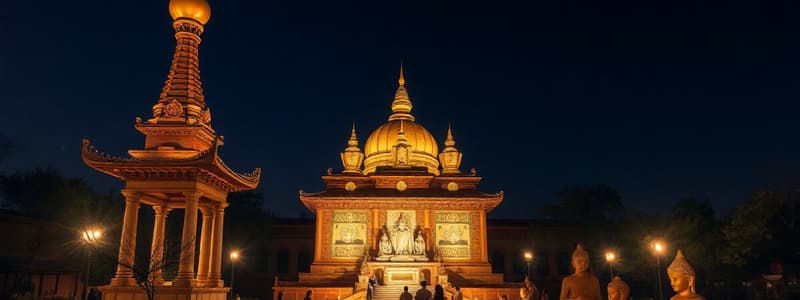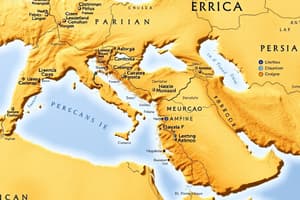Podcast
Questions and Answers
Which of the following was NOT a major empire of the post-classical era?
Which of the following was NOT a major empire of the post-classical era?
- The Mongol Empire
- The United States (correct)
- The Byzantine Empire
- The Ottoman Empire
Buddhism originated in India and spread to China, where it significantly transformed to fit local beliefs.
Buddhism originated in India and spread to China, where it significantly transformed to fit local beliefs.
True (A)
Name one major innovation that emerged from the Islamic empires during the post-classical era.
Name one major innovation that emerged from the Islamic empires during the post-classical era.
The astrolabe
The __________ is a major environmental impact caused by European maritime empires on the Americas.
The __________ is a major environmental impact caused by European maritime empires on the Americas.
Match the following figures with their contributions to Enlightenment philosophy:
Match the following figures with their contributions to Enlightenment philosophy:
What was a significant demographic impact of the European maritime empires on the Americas?
What was a significant demographic impact of the European maritime empires on the Americas?
Chattel slavery was primarily developed in response to the need for free labor in the Americas.
Chattel slavery was primarily developed in response to the need for free labor in the Americas.
Briefly explain how large states in Afro-Eurasia consolidated their power during the First Global Empires era.
Briefly explain how large states in Afro-Eurasia consolidated their power during the First Global Empires era.
Flashcards
Post-classical Empires
Post-classical Empires
Powerful empires that emerged between 600 and 1450 CE, including the Abbasid Caliphate, Byzantine Empire, Tang and Song Dynasties, and the Mayan and Aztec civilizations. These empires were known for their advanced technology, trade networks, and cultural achievements.
Islamic Empires' Innovations
Islamic Empires' Innovations
Islamic empires during the post-classical era made important contributions, including advances in mathematics, astronomy, medicine, and architecture. They also facilitated trade through innovations in navigation and communication.
Chinese Innovations (600-1450)
Chinese Innovations (600-1450)
During the post-classical era, China experienced a period of significant innovation, developing gunpowder, the compass, printing, and papermaking. These innovations had a profound impact on global trade, exploration, and communication.
Mongol Impact on Afro-Eurasia
Mongol Impact on Afro-Eurasia
Signup and view all the flashcards
First Global Empires (1450-1750)
First Global Empires (1450-1750)
Signup and view all the flashcards
Environmental Impacts of European Empires in the Americas
Environmental Impacts of European Empires in the Americas
Signup and view all the flashcards
Cash Crops and Chattel Slavery
Cash Crops and Chattel Slavery
Signup and view all the flashcards
Innovation Driving Global Empires
Innovation Driving Global Empires
Signup and view all the flashcards
Study Notes
Post-Classical Era (600-1450)
- Major Empires: Byzantine Empire, Tang Dynasty, Abbasid Caliphate, Song Dynasty, Khmer Empire.
- Islamic Innovations/Diffusions: Algebra, advancements in medicine, papermaking, advancements in astronomy, the spread of Islam, new agricultural techniques.
- Chinese Innovations: Gunpowder, printing, compass, advancements in porcelain, advancements in shipbuilding.
- Europe vs. China (Post-Classical): Europe was fragmented politically, while China experienced periods of centralized power; trade routes varied.
- Buddhism's Spread & Change: Originated in India, spread to East Asia (and other regions), adapting to local cultures.
- Rajputs: Warrior class in India.
- Crusaders: European warriors who fought in the Crusades.
- Sufis: Islamic mystics.
- Trade Innovations & Impact: Improved sailing techniques (e.g. dhows), new trade routes like the Silk Road, spurred the exchange of goods and ideas.
- Cultural Diffusion Examples: Spread of Buddhism, exchange of agricultural techniques, cultural synthesis in various regions.
- Environmental Changes from Trade: Spread of diseases (e.g., bubonic plague), new crops introduced to different regions.
- Mongol Impact: Facilitated trade across Afro-Eurasia, but also caused destruction and disruption in some areas.
First Global Empires (1450-1750)
- Major Empires (8): Ottoman, Mughal, Ming, Safavid, Russian, Songhai, Portuguese, Spanish.
- European Maritime Empires' Environmental Impacts (Americas): Introduction of disease (e.g., smallpox, measles), deforestation, soil erosion, crop displacement.
- Demographic Impacts on the Americas: Significant population decline of indigenous peoples, growth of African slave populations.
- Cash Crops: Crops grown primarily for sale, not consumption.
- Chattel Slavery: System of owning people as property.
- Connection to Cash Crops & Chattel Slavery: Need for labor to cultivate cash crops fueled the expansion of chattel slavery.
- Innovation Leading to Empires: Development of naval technology, such as advanced ship construction.
- State Power Consolidation: Building of centralized bureaucracies, military expansion, and tax systems.
- Revenue Generation: Taxes, tariffs, and tribute.
- Religious Conflicts: Religious wars between various groups.
- Social Hierarchy Changes: Emergence of new social classes related to wealth and trade status.
- China/Japan vs. Europe in Trade Policy: China/Japan favored isolationist policies, while Europe aggressively pursued trade and colonization.
Rise of the West (1750-1900)
- Renaissance Contributions: Renewed interest in classical learning.
- Enlightenment Philosophers:
- John Locke: Natural rights, social contract.
- Baron de Montesquieu: Separation of powers.
- Jean Jacques Rousseau: Social contract, general will.
- Cesare Beccaria: Criminal justice reform.
- Voltaire: Religious tolerance, freedom of speech.
- Mary Wollstonecraft: Women's rights.
- Enlightenment Impacts: Stimulated revolutions, influenced political and social thought.
- Revolutions Connected to Enlightenment Phrases:
- American Revolution: Justification for independence.
- French Revolution: Ideas of liberty, equality, fraternity.
- Haitian Revolution: Fight against slavery, equality.
- Latin American Revolutions: Similar to French & American revolutions.
Studying That Suits You
Use AI to generate personalized quizzes and flashcards to suit your learning preferences.




